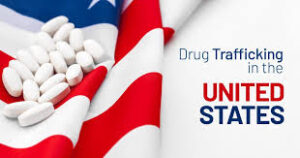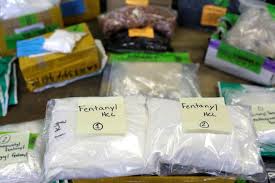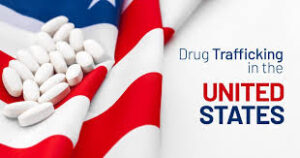Introduction

Drug trafficking remains a significant challenge in the United States, affecting communities, economies, and public health. Despite concerted efforts to combat it, the trade continues to evolve, presenting new challenges to law enforcement agencies and policymakers. This essay delves into the intricate dynamics of drug trafficking within the USA, examining its origins, impacts, and the strategies employed to address it.
Origins and Evolution of Drug Trafficking
in the USA Drug trafficking in the USA has deep-rooted origins, dating back to the 19th century with the opium trade. However, it was in the 20th century that drug trafficking became a pervasive issue, fueled by the rise of organized crime syndicates such as the Mafia and later by cartels from Latin America. The emergence of cocaine in the 1970s and 1980s, followed by the crack epidemic, further exacerbated the problem, leading to increased violence and societal decay in affected neighborhoods.
The dynamics of drug trafficking
have evolved significantly over the decades, driven by factors such as changes in drug production, transportation methods, and market demands. The advent of the internet and dark web markets has facilitated the sale of illicit drugs, providing anonymity to buyers and sellers alike. Furthermore, the legalization of cannabis in several states has reshaped the illicit drug market, with traffickers exploiting regulatory gaps to supply cannabis to regions where it remains illegal.
Impacts of Drug Trafficking

The impacts of drug trafficking on society are multifaceted and far-reaching. At the individual level, drug abuse leads to addiction, health complications, and often fatal overdoses. Families are torn apart, communities are destabilized, and the burden on healthcare and social welfare systems increases significantly. Moreover, drug-related crime, including violence, theft, and trafficking itself, imposes substantial costs on law enforcement and criminal justice systems.
Economically
the illicit drug trade has both direct and indirect consequences. It undermines legitimate businesses, fosters corruption, and distorts market mechanisms. Furthermore, the societal costs of drug abuse, including lost productivity and healthcare expenses, amount to billions of dollars annually. In regions heavily impacted by drug trafficking, economic development is hindered, as investment and tourism decline due to concerns about safety and security.
Responses fo Drug Trafficking
Addressing drug trafficking requires a multifaceted approach that encompasses law enforcement, public health initiatives, and international cooperation. Law enforcement agencies employ various tactics, including interdiction efforts, undercover operations, and intelligence gathering, to disrupt drug trafficking networks. Border security measures play a crucial role in preventing the entry of illicit drugs into the country, with enhanced technology and cooperation with foreign counterparts bolstering enforcement efforts.
In addition to law enforcement

prevention and treatment programs are essential components of the response to drug trafficking. Education and outreach efforts aim to deter individuals from experimenting with drugs and provide support to those struggling with addiction. Treatment programs offer rehabilitation services and access to medication-assisted therapy, helping individuals overcome substance abuse disorders and reintegrate into society.
Furthermore,
international cooperation is vital in addressing the transnational nature of drug trafficking. The USA collaborates with partner countries to dismantle drug cartels, disrupt smuggling routes, and stem the flow of illicit drugs across borders. Bilateral agreements, joint task forces, and intelligence sharing mechanisms facilitate coordinated action against traffickers operating across multiple jurisdictions.
Challenges and Future Directions

Despite significant efforts to combat drug trafficking, numerous challenges persist. The adaptability of traffickers, advancements in technology, and the proliferation of synthetic drugs present ongoing obstacles to law enforcement agencies. Moreover, the stigmatization of drug addiction and limited access to treatment hinder efforts to address the root causes of the problem.
Looking ahead
a comprehensive approach that combines enforcement, prevention, and treatment strategies is essential to effectively combat drug trafficking. Investing in community-based initiatives, expanding access to evidence-based treatment, and addressing socioeconomic disparities can help reduce the demand for illicit drugs and disrupt the cycle of addiction and crime. Moreover, efforts to strengthen international cooperation and address the underlying drivers of drug trafficking, such as poverty and corruption, are critical for long-term success.
Drug Trafficking Routes:
The USA serves as both a destination and transit country for illicit drugs. Traffickers utilize various routes, including land, air, and sea, to smuggle drugs into the country. The Southwest border with Mexico is a primary entry point for narcotics such as cocaine, heroin, and methamphetamine. Maritime routes along the coasts are exploited for trafficking cocaine from South America, while the Caribbean remains a key transit point for cocaine and heroin destined for the mainland.
Organized Crime Syndicates:
Drug trafficking in the USA is often controlled by organized crime syndicates, including Mexican drug cartels, Colombian drug trafficking organizations, and street gangs. These groups operate sophisticated networks involved in drug production, transportation, distribution, and money laundering. The decentralized nature of these organizations makes them difficult to dismantle, requiring sustained efforts by law enforcement agencies.
Money Laundering:
The proceeds from drug trafficking are often laundered through legitimate financial institutions, businesses, and cash-intensive industries. Money laundering techniques include structuring transactions to avoid detection, using shell companies to conceal the source of funds, and investing in real estate and high-value assets. Financial institutions are required to implement anti-money laundering (AML) measures to detect and report suspicious transactions associated with drug proceeds.
Impact on Public Health:
Drug trafficking contributes to the proliferation of illicit drugs in communities, leading to widespread substance abuse and addiction. Opioids, including prescription painkillers and synthetic opioids like fentanyl, have fueled a public health crisis in the USA, resulting in tens of thousands of overdose deaths annually. Furthermore, the availability of illicit drugs perpetuates cycles of addiction, poverty, and crime, disproportionately affecting marginalized communities.
Interplay with Legalization Efforts:
The legalization of cannabis for medical and recreational use in several states has complicated efforts to combat drug trafficking. While legalization aims to regulate the cannabis market and reduce illegal activity, it has also created opportunities for diversion and black market sales. Traffickers exploit variations in state laws and regulations to smuggle cannabis from legal to illegal markets, highlighting the need for coordinated enforcement efforts and regulatory frameworks.
Technological Challenges:
The proliferation of technology, including encrypted communication platforms and cryptocurrencies, presents challenges for law enforcement agencies combating drug trafficking. Traffickers use encrypted messaging apps and online marketplaces to facilitate drug transactions while maintaining anonymity. Cryptocurrencies such as Bitcoin provide a means of conducting illicit transactions without traditional financial intermediaries, complicating efforts to trace and seize illicit proceeds.
Collateral Consequences:
Beyond the direct impacts on public health and safety, drug trafficking has collateral consequences for individuals and communities. Mass incarceration resulting from harsh drug sentencing laws disproportionately affects minority populations, exacerbating racial disparities within the criminal justice system. Moreover, the stigma associated with drug addiction often prevents individuals from seeking treatment and support, perpetuating cycles of substance abuse and criminality.

In addressing the multifaceted nature of drug trafficking, policymakers and stakeholders must adopt holistic approaches that address supply reduction, demand reduction, and harm reduction strategies. By combining law enforcement efforts with prevention, treatment, and international cooperation, the USA can mitigate the harms associated with drug trafficking and work towards building healthier, safer communities.
conclusion
Drug trafficking remains a complex and persistent challenge in the United States, with far-reaching consequences for individuals, communities, and societies at large. Addressing this multifaceted issue requires a coordinated and comprehensive response that encompasses law enforcement, public health, and international cooperation. By tackling the root causes of drug trafficking and investing in prevention and treatment efforts, the USA can mitigate the harms associated with illicit drug trade and build safer, healthier communities for future generations.



